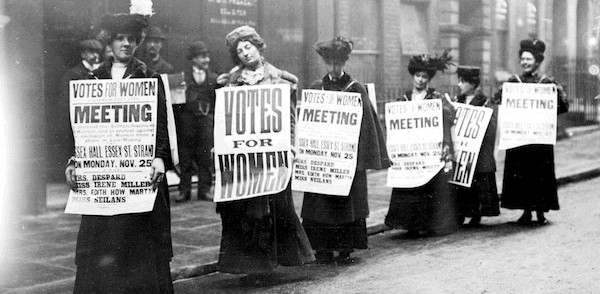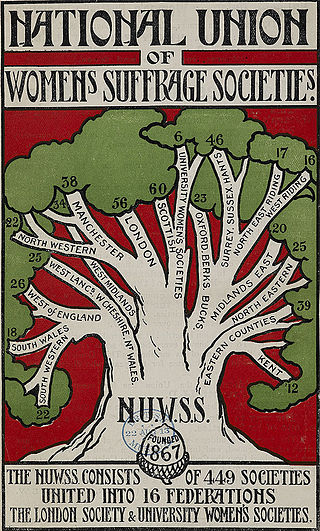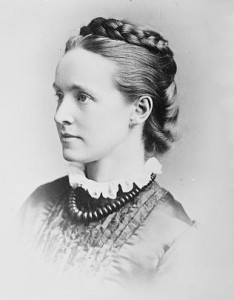
The Suffragist movement in Lancaster was formalised in 1911 when the Lancaster Suffrage Society was founded. Chris Workman gives an account in this article of some of the activities of Society members, including their involvement in the NUWSS Women’s Suffrage Pilgrimage to London in 1913, which passed through Lancaster on the route down from Carlisle
The Suffragist Movement in Lancaster
Posted by Christine Workman
The Suffragette activity in Lancaster is well documented through the Lancaster Guardian and includes the activities of women, such as Selina Martin and Hilda Birkett, in locations as far afield as Liverpool, Birmingham and Folkestone. Their more moderate counterparts, the Suffragist members of the National Union of Women’s Suffrage Societies (NUWSS), have proved to be more elusive, yet also made their mark on the politics and attitudes of early twentieth century Lancaster.
Formation of the Lancaster Suffrage Society
Lancaster did not establish its own Suffragist Society until December 1911 [1]. This is surprisingly late, as the NUWSS had been formed in 1897 from earlier women’s groups led by Mrs Millicent Fawcett. However, the new society in Lancaster was part of a new wave of groups that were established at the time, as the suffrage campaign gained momentum after the failure of the Conciliation Bill that had seemed to promise so much for women [2].
Lancaster did not establish its own Suffragist Society until December 1911.
The leading lights in the formation of the Lancaster Suffragist Society were key Liberal ladies of the town: Mrs George Barrow, Miss Cassidy, Miss Davies of Carus Lodge, Miss Mellor, Mrs H. A. Watson and Mrs (Croft) Helme, who was the sister-in-law of Lancaster’s Liberal M.P., Norval Helme [3]. In December 1911 they organised an ‘At Home’ on a Monday afternoon to be held in the old Church House. About 100 ladies accepted, had tea, and were then addressed by Miss Norma Smith, who explained that the meeting was held under the auspices of the National Union of Suffrage Societies. She emphasised that the society was entirely non-militant, law-abiding and non-party, and had no connection whatsoever with the militant Suffragettes. She gave reasons why every woman should be interested in women’s suffrage. A key purpose was to help the less fortunate women get a vote to protect their interests in the home and the labour market, illustrated by discussing women’s wages. The peaceful nature of this protest group was emphasised.
Miss Smith said that the NUWSS still held the government to their promise of a week of time for the Conciliation Bill and in the meantime encouraged the women to work to secure a majority for the amendment to the government Reform Bill. She was very informative, explaining that the amendment most likely to get most support would enfranchise women householders and wives of voters. This meeting was very successful, as sixty women said that they would join the Lancaster Branch of the NUWSS. A committee was formed with Mrs Croft Helme and Miss Mellor as secretaries. Eleven other women were committee members.
A key purpose was to help the less fortunate women get a vote to protect their interests in the home and the labour market, illustrated by discussing women’s wages.
Suffrage Society Activities in Lancaster
There are no known records of the Suffrage Society. However, their activities are noted at various events in the years up to the war. One of the earliest mention of a Suffragist is in September 1912, when the Women’s Liberal Association of Lancaster was addressed by Mrs Bliss of Boarbank Hall, Grange over Sands [4]. She was described as ‘not a Suffragette but a Suffragist’. The focus of her talk was her concern with women’s lack of interest in politics. It was reported that Mrs Bliss believed that the Suffragettes had delayed the vote. It is interesting to note that although the WLA had 1200 women enrolled as members in North Lonsdale, the Lancaster Division had 231 and only 80 of these were in Lancaster [5].
The main event in Suffragist terms was the Non-Militant Suffragist March to London in June 1913, which passed through Lancaster. The marchers had received a warm welcome in Carnforth. They marched to Lancaster, where they arrived in the late afternoon. With a banner carried by Mrs T. Taylor and Nurse Garside of Lancaster, they processed around the town, up North Road, Cheapside and Penny Street, the streets being ‘lined by a large number of townspeople, including many sympathisers’ [6]. The marchers had tea at Springfield Hall, the home of Sir Norval Helme, M.P. In the evening, a meeting was held in the Ashton Hall, where they were addressed by Miss Matters [7] and Sir N. Helme. The newspaper said that some ladies wore their red, green and white sashes and literature was distributed.
Although the Suffragists were not politically aligned, the group in Lancaster had members such as Annie Helme, who were associated with the Liberals, who did address the issue of suffrage. The Lancaster Branch of the League of Young Liberals held a meeting in the Reform Club Reading Room and debated women’s suffrage [8]. The all-male audience held differing views. The Chairman, Mr Arthur Wilson, said he favoured an extension of suffrage but that the recent conduct of the militant suffragettes rather made him pause. Mr W. Garth was not in favour. Sir Norval Helme M.P. voted in favour of the second reading of the 1913 Women’s Suffrage Bill.
This meeting was very successful, as sixty women said that they would join the Lancaster Branch of the NUWSS.
Millicent Fawcett Visits Lancaster
In 1914, Mrs Fawcett, the Suffragist leader, was herself in Lancaster and, along with Miss Matters, addressed a meeting in the Ashton Hall, Lancaster, the Albert Hall in Morecambe and the Victoria Hall in Carnforth. There was a definite disassociation from the militant suffragettes, calling them ‘misguided.’ The resolution to demand a government measure to enfranchise women was passed.
At the outbreak of war, the Suffragists in Carnforth offered their services for dealing with any distress owing to the war. It is assumed that Lancaster did the same.
With a banner carried by Mrs T. Taylor and Nurse Garside of Lancaster, they processed around the town, up North Road, Cheapside and Penny Street, the streets being ‘lined by a large number of townspeople, including many sympathisers’.
- [1] Lancaster Guardian, 16th December 1911; p.8d.
- [2] According to Harold L. Smith in his 2014 book, The British Women’s Suffrage Campaign, 1866-1928 (2nd ed. London: Routledge), the 1911 Conciliation Bill aimed to give the vote to approximately one million women who were already local government electors. It passed its Second Reading in the House of Commons by a large majority and the NUWSS campaigned for a week of Parliamentary time to proceed with the Bill. This was denied, although Asquith offered a week in the next session. However, Liberals like Lloyd George feared that the Bill would add Conservative voters, so they persuaded Asquith to introduce a new Franchise Bill for men that would allow amendments on women’s suffrage and be passed by the end of 1912. The Suffragettes, disappointed, reactivated their militant campaign; the Suffragists maintained their support, but the 1912 Conciliation Bill was subsequently defeated.
- [3] See Chris Workman’s article, ‘Annie Elizabeth Helme: A Pioneer of Equality for Women’ [insert hyperlink to this article] for more information about Mrs Helme’s involvement in the suffrage movement and subsequent political career.
- [4] Mrs Bliss may be the wife of Mr Joseph Bliss, J.P., owner of the Hall at that time.
- [5] Lancaster Guardian,28th September 1912; p.5b.
- [6] Lancaster Guardian, 5th July 1913; p.3e.
- [7] Miss Matters was a voter from Australia.
- [8] Lancaster Guardian, 16th December 1913; p.8.



